|
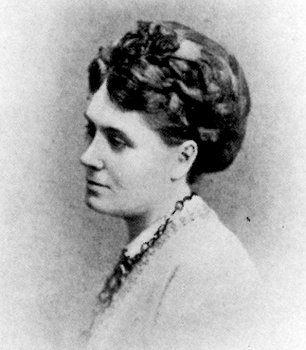
A rare photograph of Alice
Kipling.
|
|
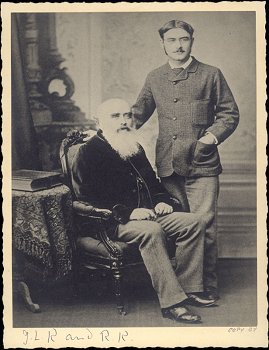
Rudyard Kipling (standing) with his father, John Lockwood Kipling c.1880. |
In June 1868 Alice Kipling was back in Britain. She
had a difficult time giving birth to her daughter whilst
staying with her sister Georgiana at the Grange, Fulham.
The house was full of furnishings and decorations from
Morris and Company. Burne-Jones designed stained glass
and tapestries for the business. Rudyard had been left
with his grandparents in Bewdley. In November, the
Kiplings travelled back to India just six days before
Alice's father died in Bewdley.
John Lockwood Kipling was made a Companion of the Indian
Empire in 1887. Alice Kipling died in 1910, the year
before her husband.
Their son Joseph Rudyard Kipling (1865-1936) was one of
the most celebrated writers of the late 19th and early
20th centuries; the Jungle Book was published in 1894.
He was awarded the Nobel Prize for Literature in 1907.
He later declined a Knighthood and the role of Poet
Laureate.The Poynters |
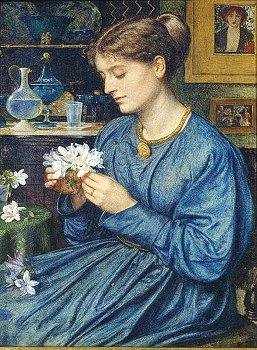
A portrait of Agnes Macdonald by
Edward Poynter. Completed shortly before their marriage
in Wolverhampton in 1866. |
|
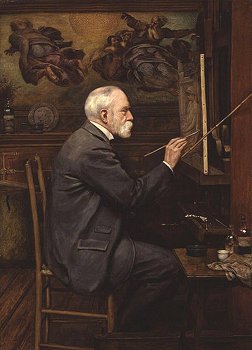
Sir Edward Poynter by Sir Philip
Burne-Jones, 1909.
|
Edward Poynter's successful career led to his
appointment as Director of the National Gallery
(1894-1905) and President of the Royal Academy
(1896-1918), the first person to hold both posts at the
same time. He was awarded a Knighthood in 1896 (upgraded
to a Baronetcy in 1902) and was appointed Slade
Professor of Art at University College London. Lady
Agnes Poynter died in 1906, Sir Edward in 1919. Poynter
painted three of the four sisters. According to Jan
Marsh, by showing Agnes holding flowers and Louisa
holding a fan, he shows them as 'artistic women'; Louisa
being painted in a particularly 'Rossetti-like pose ',
whereas Georgiana is shown as a 'society lady, sipping
her tea'.
Their eldest son, Sir Ambrose Poynter (1867-1923), 2nd
Baronet, became a successful architect, while their
younger son, Hugh (1882-1968), joined his cousin's
company, E. P. and W. Baldwin.
The Burne-Jones's |
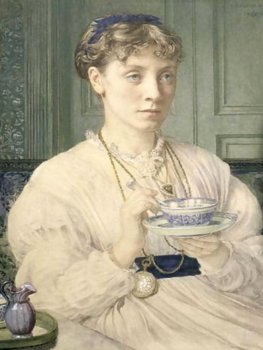
Georgiana Burne-Jones, around 1870, by Poynter. |
|
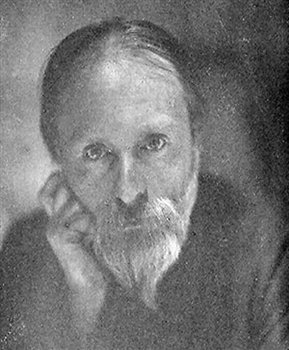
Edward Burne- Jones photographed by
Frederick Hollyer in 1890. |
There was a wealthy group of Greek merchants and
bankers in London in the 1860s. Maria Cassavetti, a
beautiful, rich, first cousin of Alecco Ionides was one
of this group. She married a Greek doctor (Zambaco) in
1863, had three children, but by 1866 she had separated
from her husband, leaving him with their children in
Paris while she moved back to London. After Maria began
sitting for Burne-Jones they began an affair that rocked
the marriage of Edward and Georgiana. In January 1869
the affair became public knowledge due to a failed
attempt by the couple to run away to the continent.
Burne-Jones got cold feet but continued a liaison with
her for many years; unsurprisingly this created
difficulties in the Burne-Jones marriage .
Burne-Jones was a very successful artist, gaining an
international reputation, culminating in his acceptance
of a Baronetcy in 1894. Georgiana and William Morris
were unhappy about his elevation; they were both
confirmed Socialists. Georgiana was elected a Parish
Councillor for Rottingdean, Sussex, where they had a
holiday home. This had become possible after the 1894
Act which allowed women to stand for, and vote in,
Parish Councils for the first time. (The full franchise
would only be achieved after another 25 years). Sir
Edward Burne-Jones died in 1898. After his death, Lady
Georgiana moved permanently to their holiday home in
Rottingdean, surviving him until 1920. |
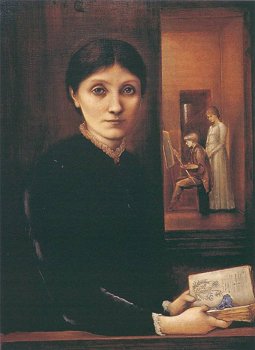
A portrait of Georgiana
Burne-Jones by Edward Burne-Jones, 1883. |
Also depicted are her artist son Philip (1861-1926),
2nd and last Baronet, and her daughter Margaret, who
married William Morris's biographer Jack Mackail.
Their daughter was the writer Angela Thirkell, whose
Barsetshire novels were popular in the mid-20th century.
|
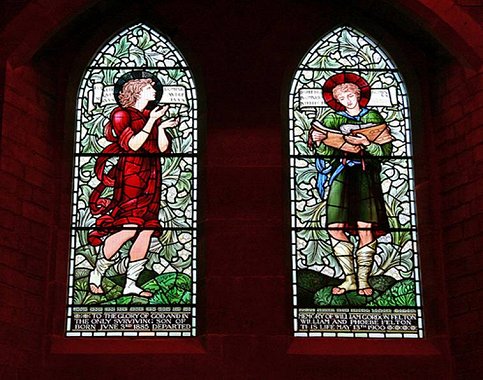
Glass at Wilden church designed by
Burne-Jones.
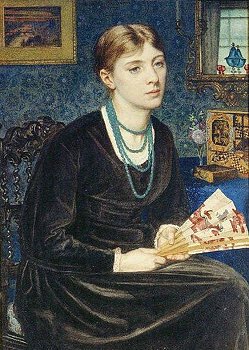
Portrait of Louisa Baldwin in 1868, by Edward Poynter. |
|

Alfred Baldwin.
|
From November 1870 the Baldwins moved to Wilden
House to be nearer the iron works business. In 1877
Alfred Baldwin changed his allegiance from the Liberals
to the Conservatives, becoming MP for West
Worcestershire from 1892 until his death in 1908. In
1882 Alfred paid for a church to be built in Wilden.
Morris and Company made all of the stained glass windows
to the designs of Burne-Jones as well as furnishing
other decoration, including an altar front designed by
Morris and embroidered by Edith Macdonald. Fittingly, it
is the only church to contain memorials to all of the
Macdonald sisters.
After Alfred's death in 1908 his son Stanley was elected
to represent his constituency in Parliament and he also
became a Director of the GWR. Stanley Baldwin climbed
the political ladder to become Prime Minister three
times from 1923-4, 1924-9 and 1935-7. His mother Louisa
lived until 1925, just long enough to see her son
achieve the pinnacle of his career.
There is an interesting parallel with our new government
(May 2010). Stanley Baldwin was instrumental in the
downfall of Liberal Prime Minster David Lloyd-George,
who led the last Liberal-Conservative Government which
Baldwin joined as a member of the Cabinet in 1921, as
President of the Board of Trade. At the Carlton Club, in
October 1922, Baldwin met other Conservative MPs unhappy
with the Coalition government, condemning Lloyd-George
as a 'dynamic force' who was corrupt (selling honours),
who had split the Liberals and would split the
Conservatives. Baldwin and the other MPs withdrew their
support of the Coalition. The General Election that
followed returned the Conservatives with their own
majority, under Prime Minister Andrew Bonar Law (the
only P. M. born outside the British Isles). Baldwin
served as Chancellor, before succeeding the terminally
ill Bonar Law as Prime Minister in 1923. After retiring
as an MP he was created 1st Earl Baldwin of Bewdley.
|
 |
|
 |
|
 |
|
Return to QueenVictoria's Visit |
|
Return to
the beginning |
|
Proceed to
The Next Generation |
|